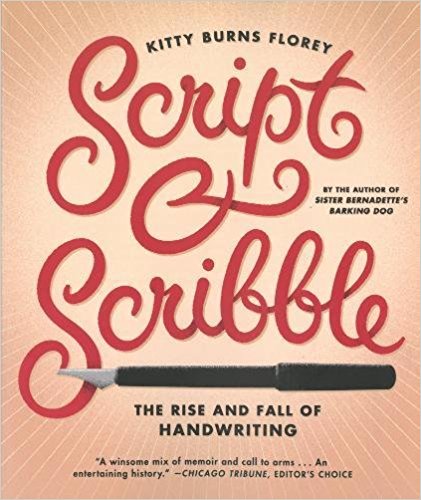Script & Scribble:
The Rise and Fall of Handwriting
by Kitty Burns Florey
–Review by Teri Hyrkas
“I have a dilemma…. It is much easier and faster for me to write in cursive than to print, and my penmanship is near perfect mind you. Many of my students cannot read the comments that I write on their homework. Should I get with the times and print or should I put it on them to find someone to translate the cursive for them?” 09.13.17
The above request for help was taken from a recent Facebook post of a young friend, a teacher of ninth and tenth grade math students named Jodi. Her entry triggered several days of discussion on Jodi’s Facebook status. I found the comments intriguing and quite timely as I had just started reading the book by Kitty Burns Florey called Script & Scribble: The Rise and Fall of Handwriting (Melville House Publishing, 2009). Florey, whose early education included several years of Palmer Method penmanship training, has produced a thoroughly enjoyable and very perceptive overview of the state of handwriting in the US. And not surprisingly, Script & Scribble has some pertinent information to contribute to the debate on Jodi’s “cursive vs. printing” dilemma.
It is easy to think of handwriting as simple and straightforward, but that would be a mistake. Florey points out that the human desire to record and communicate information goes back to the time of cave dwellers who scratched hunting scenes on their walls. For most of history, to make a record of events one has needed a tool with which to write and a surface to receive the writing, whether it was sharp stones and cave walls, wax tablets and a stylus, papyrus, ink and a reed, or pen and paper. To make the exchange of information truly efficient another feature of communication was necessary — a system that made inscriptions understandable to others. The first systems developed were pictograms and hieroglyphs, but “sometime before the first millennium B.C.,” Flory says, “… the Phoenicians [transformed] the pictograms into a true alphabet…. Gradually, a complete alphabet evolved and — with some modifications and editions over the flow of time — it’s the alphabet we use today.”
In Script & Scribble, Florey describes and illustrates numerous script styles that have come about over the centuries. Various styles that were good for speed and clarity were used for business. Other scripts, admired primarily for their beauty, were sought out for formal documents. Some scripts became works of art when used for such things as calligraphed Bibles and prayer books. But a script which is judged to be beautiful by one person may be viewed as unsavory by another. Florey writes that during the post-Renaissance years, script modifications “were about neither art nor speed: they were about morality. For Puritans and other reformers in England and America, the scripts favored in Europe were too elaborate, too baroque — perhaps too seductively gorgeous — and the plain and easy script known as copperplate (or roundhand) was devised as an alternative.”
In the chapter called “Writing by Hand in a Digital Age,” Florey brings the reader into the present and addresses many of the issues that surround teaching cursive to children. Florey acknowledges that there is plenty of resistance from those who see cursive as a waste of school time. In response to the pushback, the author presents specialists’ assertions that a link can be confirmed between penmanship training and a child’s ability to learn to read; thus cursive has value in helping children “break the code” between recognizing letters and reading words.
Further on in the chapter Florey includes a marvelous segment on Lloyd Reynolds (1902-78), an English professor at Reed College in Portland, Oregon. Florey writes that Reynolds had been under the spell of lettering all his life, and began promoting Italic cursive script at Reed by teaching a calligraphy course there. Among Reynolds’ calligraphy students was the founder of Apple, Inc., Steve Jobs. Jobs credits Reynolds’ calligraphy class with being the reason that the Macintosh was the first personal computer to offer a selection of beautiful typefaces and fonts. Because Jobs remembered the beauty of script and incorporated it into the Macintosh, the digital world pays homage to calligraphy every day.
Perhaps the most important issue in Script & Scribble is one that directly affects the situation in Jodi’s classroom, and likely other classrooms, too: Is it feasible to teach elementary students cursive in today’s public school environment? It is clear from Jodi’s challenging situation that if one can’t write cursive, one will likely have a hard time reading it. Is there a workable solution to this issue? Here is what Jodi decided to do to solve her immediate problem:
“I have been printing comments on tests/quizzes when the stakes are higher but writing comments in cursive on daily work. I will continue to do this at least until I have time to make a poster [of a cursive alphabet] so that students can decode their messages.”
Will this compromise be sufficient for my friend? For her students? Only time will tell.
Judging by the level of response on Facebook, to teach or not to teach cursive in public elementary schools is a hot topic. If you are interested in the subject, Script & Scribble: The Rise and Fall of Handwriting by Kitty Burns Florey presnts a fascinating account of the precarious state of penmanship in the U.S.

